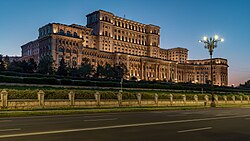| Palace of the Parliament | |
|---|---|
Palatul Parlamentului | |
 The Palace in 2024 | |
 | |
| Former names | "House of the Republic" |
| Alternative names | "The People's House" |
| General information | |
| Architectural style | Postmodern (mainly Neoclassical, described as "Neo-Neoclassical") |
| Address | Strada Izvor 2-4 |
| Town or city | Bucharest |
| Country | Romania |
| Coordinates | 44°25′39″N 26°5′15″E / 44.42750°N 26.08750°E |
| Groundbreaking | 25 June 1984 |
| Completed | 1997 |
| Cost | €4 billion euros |
| Height | |
| Architectural | 84 m (276 ft) |
| Technical details | |
| Size | 240 m (790 ft) long, 270 m (890 ft) wide |
| Floor count | 12 |
| Floor area | 365,000 m2 (3,930,000 sq ft) |
| Grounds | 66,000 m2 |
| Design and construction | |
| Architect(s) | 700 architects under the direction of chief architect Anca Petrescu (1949–2013) |
| Designations |
|
| Other information | |
| Number of rooms | 1,100 |
The Palace of the Parliament (Romanian: Palatul Parlamentului), also known as the House of the Republic (Casa Republicii) or People's House/People's Palace (Casa Poporului), is the seat of the Parliament of Romania, located atop Dealul Spirii in Bucharest, the national capital. The Palace reaches a height of 84 m (276 ft),[1] has a floor area of 365,000 m2 (3,930,000 sq ft)[2] and a volume of 2,550,000 m3 (90,000,000 cu ft). The Palace of the Parliament is the heaviest building in the world, weighing about 4,098,500 tonnes (9.04 billion pounds), and is the third largest administrative building in the world.[3]
The building was designed and supervised by chief architect Anca Petrescu, with a team of approximately 700 architects, and constructed over a period of 13 years (1984–1997) in modernist Neoclassical architectural forms and styles,[4] with socialist realism in mind.[5] The Palace was ordered by Nicolae Ceaușescu (1918–1989), the president of Communist Romania and the second of two long-ruling heads of state in the country since World War II,[6] during a period in which the personality cult of political worship and adoration increased considerably for him and his family.[7]
Known for its ornate interior composed of 23 sections, the palace houses the two chambers of the Parliament of Romania: the Senate (Senat) and the Chamber of Deputies (Camera Deputaților), along with three museums and an international conference center. The museums in the Palace are the National Museum of Contemporary Art, the Museum of Communist Totalitarianism (established in 2015)[8] and the Museum of the Palace. Though originally named the House of the Republic when under construction, the palace became widely known as The People's House after the Romanian Revolution of December 1989. Due to its impressive characteristics, events organized by state institutions and international bodies such as conferences and symposia take place there, but despite this about 70% of the building remains empty.[9][10]
As of 2020[update], the Palace of the Parliament is valued at €4 billion, making it the most expensive administrative building in the world.[11] The cost of heating, electricity, and lighting alone exceeds $6 million per year.[12]
The old Palace of the Chamber of Deputies is now the Palace of the Patriarchate.
- ^ Walker, Shaun (22 December 2019). "Romania comes to terms with monument to communism 30 years after Ceaușescu's death". The Guardian. Retrieved 19 December 2021.
- ^ "Palace of Parliament". Bucharest International Conference Centre. Retrieved 19 December 2021.
- ^ "Heaviest building". Guinness World Records.
- ^ "Anca Petrescu". The Telegraph. 11 July 2018.
- ^ Cite error: The named reference
:0was invoked but never defined (see the help page). - ^ Munteanu, Teodora (12 February 2018). "Megalomania lui Ceaușescu: dorința de a merge pe sub București și povestea catacombelor secrete". Ediția de Dimineață (in Romanian).
- ^ Covrig, Roxana (3 August 2013). "Se muncea, dar se și murea. Povești cutremurătoare de pe șantierele lui Ceaușescu".
- ^ "Senatul a adoptat legea privind infiintarea Muzeului Totalitarismului Comunist. Academia Romana va intocmi si un raport de condamnare a comunismului". HotNews.ro. 22 September 2015.
- ^ "Palatul Parlamentului, o emblema a Bucurestiului". Hotel-Bucuresti.com. 29 April 2015.
- ^ Malathronas, John (5 December 2014). "Palace of the damned dictator: On the trail of Ceausescu in Bucharest". CNN.
- ^ "Casa Poporului – de trei ori în Cartea Recordurilor". Gândul. 4 April 2008. Archived from the original on 27 July 2018.
- ^ Andrei Pandele (September 2008). "Palatul Parlamentului din Casa Poporului". National Geographic România. Archived from the original on 23 March 2016.